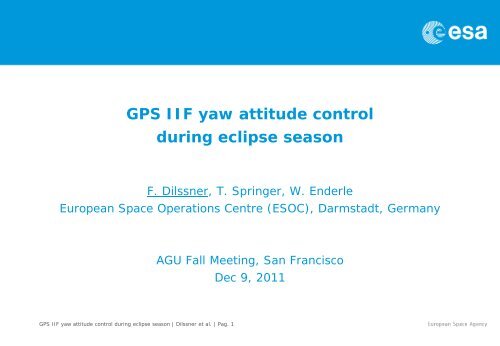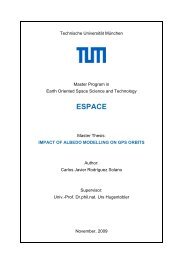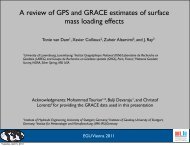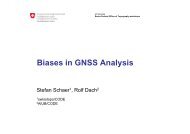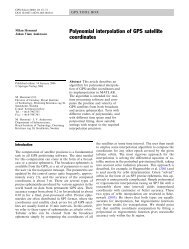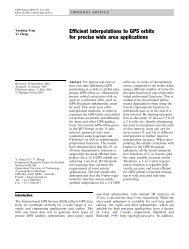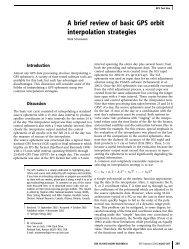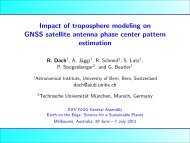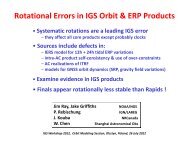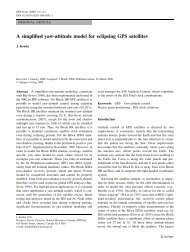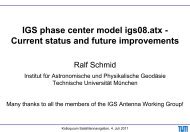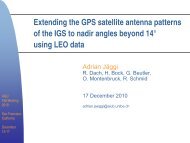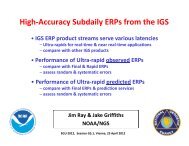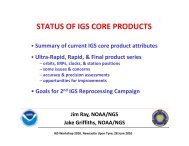GPS IIF yaw attitude control during eclipse season - IGS Analysis ...
GPS IIF yaw attitude control during eclipse season - IGS Analysis ...
GPS IIF yaw attitude control during eclipse season - IGS Analysis ...
You also want an ePaper? Increase the reach of your titles
YUMPU automatically turns print PDFs into web optimized ePapers that Google loves.
<strong>GPS</strong> <strong>IIF</strong> <strong>yaw</strong> <strong>attitude</strong> <strong>control</strong><br />
<strong>GPS</strong> <strong>IIF</strong> <strong>yaw</strong> <strong>attitude</strong> <strong>control</strong> <strong>during</strong> <strong>eclipse</strong> <strong>season</strong> | Dilssner et al. | Pag. 1<br />
<strong>during</strong> <strong>eclipse</strong> <strong>season</strong><br />
F. Dilssner, T. Springer, W. Enderle<br />
European Space Operations Centre (ESOC), Darmstadt, Germany<br />
AGU Fall Meeting, San Francisco<br />
Dec 9, 2011
Sun-nadir-steering (1/2)<br />
– L-band antenna needs to be pointed<br />
toward geocenter; solar panels have<br />
to be perpendicular to Sun direction<br />
– Orientation (“<strong>attitude</strong>”) needs to be<br />
continuously adjusted through <strong>yaw</strong><br />
and pitch <strong>control</strong><br />
– ADCS provides sensors (Earth, Sun,<br />
Gyro) and effectors (reaction wheels,<br />
torque rods)<br />
<strong>GPS</strong> <strong>IIF</strong> <strong>yaw</strong> <strong>attitude</strong> <strong>control</strong> <strong>during</strong> <strong>eclipse</strong> <strong>season</strong> | Dilssner et al. | Pag. 2
Sun-nadir-steering (2/2)<br />
<strong>GPS</strong> <strong>IIF</strong> <strong>yaw</strong> <strong>attitude</strong> <strong>control</strong> <strong>during</strong> <strong>eclipse</strong> <strong>season</strong> | Dilssner et al. | Pag. 3
Today’s focus<br />
– Shadow-crossing maneuvers: How does <strong>GPS</strong> Block <strong>IIF</strong> S/C <strong>control</strong> its <strong>yaw</strong><br />
<strong>attitude</strong> when solar sensors’ view of the Sun is obstructed by the Earth /<br />
the Moon?<br />
– Noon-turn maneuver: How does S/C perform its noon-turn to keep +X side<br />
facing the Sun?<br />
Yaw angle is crucial for precise satellite antenna phase centre and clock modeling<br />
<strong>GPS</strong> <strong>IIF</strong> <strong>yaw</strong> <strong>attitude</strong> <strong>control</strong> <strong>during</strong> <strong>eclipse</strong> <strong>season</strong> | Dilssner et al. | Pag. 4
Estimated <strong>GPS</strong> <strong>IIF</strong> satellite antenna PCVs<br />
<strong>GPS</strong> <strong>IIF</strong> <strong>yaw</strong> <strong>attitude</strong> <strong>control</strong> <strong>during</strong> <strong>eclipse</strong> <strong>season</strong> | Dilssner et al. | Pag. 5
Evidence for <strong>GPS</strong> <strong>IIF</strong> <strong>yaw</strong> <strong>attitude</strong> modeling issues<br />
<strong>GPS</strong> <strong>IIF</strong> <strong>yaw</strong> <strong>attitude</strong> <strong>control</strong> <strong>during</strong> <strong>eclipse</strong> <strong>season</strong> | Dilssner et al. | Pag. 6
Epoch-wise <strong>yaw</strong> angle estimation<br />
– 30-sec code & phase measurements<br />
from global <strong>IGS</strong> tracking network<br />
– 1 st step: <strong>IGS</strong>-like GNSS analysis<br />
– 2 nd step: Resolving satellite clocks &<br />
phase centre positions epoch-by-epoch<br />
(“reverse kinematic point positioning”)<br />
– “Nominal” <strong>yaw</strong> <strong>attitude</strong> model employed<br />
– Yaw error reflected in horizontal PCOs<br />
<strong>GPS</strong> <strong>IIF</strong> <strong>yaw</strong> <strong>attitude</strong> <strong>control</strong> <strong>during</strong> <strong>eclipse</strong> <strong>season</strong> | Dilssner et al. | Pag. 7
Midnight-turn regime (1/2)<br />
– Linear drift in <strong>yaw</strong> angle estimates as<br />
soon as S/C enters umbra<br />
– S/C is rotating around its z-axis with<br />
nearly constant rate (here: ≈ 0.06º/s)<br />
– S/C keeps “natural” sense of rotation<br />
due to <strong>yaw</strong> bias which is set to have<br />
the same sign as β-angle<br />
– Yaw angle upon shadow exit may be off<br />
from “nominal” value forcing S/C to<br />
perform short post-shadow recovery<br />
maneuver (< 5 min)<br />
<strong>GPS</strong> <strong>IIF</strong> <strong>yaw</strong> <strong>attitude</strong> <strong>control</strong> <strong>during</strong> <strong>eclipse</strong> <strong>season</strong> | Dilssner et al. | Pag. 8
Midnight-turn regime (1/2)<br />
– Linear drift in <strong>yaw</strong> angle estimates as<br />
soon as S/C enters umbra<br />
– S/C is rotating around its z-axis with<br />
nearly constant rate (here: ≈ 0.06º/s)<br />
– S/C keeps “natural” sense of rotation<br />
due to <strong>yaw</strong> bias which is set to have<br />
the same sign as β-angle<br />
– Yaw angle upon shadow exit may be off<br />
from “nominal” value forcing S/C to<br />
perform short post-shadow recovery<br />
maneuver (< 5 min)<br />
<strong>GPS</strong> <strong>IIF</strong> <strong>yaw</strong> <strong>attitude</strong> <strong>control</strong> <strong>during</strong> <strong>eclipse</strong> <strong>season</strong> | Dilssner et al. | Pag. 9
Midnight-turn <strong>yaw</strong>-rate estimates (1/2)<br />
– Yaw-rate estimates for 228 <strong>eclipse</strong><br />
events (SVN-62: #176, SVN-63: #52)<br />
– Yaw-rate varies through the <strong>eclipse</strong><br />
<strong>season</strong>; the lower the β-angle, the<br />
higher the rate<br />
– Estimates for β > 0° closely match<br />
thereoretical expectations; values for<br />
β < 0° tend to be higher as expected<br />
– Difference between high rate (β < 0°)<br />
and low rate (β > 0°) values of<br />
0.005°/s<br />
<strong>GPS</strong> <strong>IIF</strong> <strong>yaw</strong> <strong>attitude</strong> <strong>control</strong> <strong>during</strong> <strong>eclipse</strong> <strong>season</strong> | Dilssner et al. | Pag. 10
Midnight-turn <strong>yaw</strong>-rate estimates (1/2)<br />
– Yaw-rate estimates for 228 <strong>eclipse</strong><br />
events (SVN-62: #176, SVN-63: #52)<br />
– Yaw-rate varies through the <strong>eclipse</strong><br />
<strong>season</strong>; the lower the β-angle, the<br />
higher the rate<br />
– Estimates for β > 0° closely match<br />
thereoretical expectations; values for<br />
β < 0° tend to be higher as expected<br />
– Difference between high rate (β < 0°)<br />
and low rate (β > 0°) values of<br />
0.005°/s<br />
<strong>GPS</strong> <strong>IIF</strong> <strong>yaw</strong> <strong>attitude</strong> <strong>control</strong> <strong>during</strong> <strong>eclipse</strong> <strong>season</strong> | Dilssner et al. | Pag. 11
Midnight-turn <strong>yaw</strong>-rate estimates (2/2)<br />
– Yaw-rate parameter can be well<br />
described by two “block-specific” 2 nd<br />
order polynomials<br />
– De-trended rate estimates exhibit RMS<br />
of ±0.0014°/s<br />
– Yaw rate uncertainty translates into<br />
uncertainty in <strong>yaw</strong> angle of ±5° at the<br />
end of a 55-min <strong>eclipse</strong> event<br />
<strong>GPS</strong> <strong>IIF</strong> <strong>yaw</strong> <strong>attitude</strong> <strong>control</strong> <strong>during</strong> <strong>eclipse</strong> <strong>season</strong> | Dilssner et al. | Pag. 12
Midnight-turn <strong>yaw</strong>-rate estimates (2/2)<br />
– Yaw-rate parameter can be well<br />
described by two “block-specific” 2 nd<br />
order polynomials<br />
– De-trended rate estimates exhibit RMS<br />
of ±0.0014°/s<br />
– Yaw rate uncertainty translates into<br />
uncertainty in <strong>yaw</strong> angle of ±5° at the<br />
end of a 55-min <strong>eclipse</strong> event<br />
<strong>GPS</strong> <strong>IIF</strong> <strong>yaw</strong> <strong>attitude</strong> <strong>control</strong> <strong>during</strong> <strong>eclipse</strong> <strong>season</strong> | Dilssner et al. | Pag. 13
Midnight-turn <strong>yaw</strong>-rate estimates (2/2)<br />
– Yaw-rate parameter can be well<br />
described by two “block-specific” 2 nd<br />
order polynomials<br />
– De-trended rate estimates exhibit RMS<br />
of ±0.0014°/s<br />
– Yaw rate uncertainty translates into<br />
uncertainty in <strong>yaw</strong> angle of ±5° at the<br />
end of a 55-min <strong>eclipse</strong> event<br />
<strong>GPS</strong> <strong>IIF</strong> <strong>yaw</strong> <strong>attitude</strong> <strong>control</strong> <strong>during</strong> <strong>eclipse</strong> <strong>season</strong> | Dilssner et al. | Pag. 14
“Nominal” <strong>attitude</strong> model vs. new <strong>attitude</strong> model<br />
<strong>GPS</strong> <strong>IIF</strong> <strong>yaw</strong> <strong>attitude</strong> <strong>control</strong> <strong>during</strong> <strong>eclipse</strong> <strong>season</strong> | Dilssner et al. | Pag. 15
Noon-turn regime<br />
– S/C cannot keep up with required <strong>yaw</strong><br />
rate, if |β| < 4.5°<br />
– Estimated and “nominal” <strong>yaw</strong> angle<br />
diverge under small negative β-angle<br />
(-0.9° < β < 0°); ∆ψ adds up to 360°<br />
– Linear drift in <strong>IGS</strong> clock solutions in<br />
the range of 0.4 ns (0.12 m) due to<br />
phase wind-up mismodeling<br />
<strong>GPS</strong> <strong>IIF</strong> <strong>yaw</strong> <strong>attitude</strong> <strong>control</strong> <strong>during</strong> <strong>eclipse</strong> <strong>season</strong> | Dilssner et al. | Pag. 16
Noon-turn regime<br />
– S/C cannot keep up with required <strong>yaw</strong><br />
rate, if |β| < 4.5°<br />
– Estimated and “nominal” <strong>yaw</strong> angle<br />
diverge under small negative β-angle<br />
(-0.9° < β < 0°); ∆ψ adds up to 360°<br />
– Linear drift in <strong>IGS</strong> clock solutions in<br />
the range of 0.4 ns (0.12 m) due to<br />
phase wind-up mismodeling<br />
<strong>GPS</strong> <strong>IIF</strong> <strong>yaw</strong> <strong>attitude</strong> <strong>control</strong> <strong>during</strong> <strong>eclipse</strong> <strong>season</strong> | Dilssner et al. | Pag. 17
Noon-turn regime<br />
– S/C cannot keep up with required <strong>yaw</strong><br />
rate, if |β| < 4.5°<br />
– Estimated and “nominal” <strong>yaw</strong> angle<br />
diverge under small negative β-angle<br />
(-0.9° < β < 0°); ∆ψ adds up to 360°<br />
– Linear drift in <strong>IGS</strong> clock solutions in<br />
the range of 0.4 ns (0.12 m) due to<br />
phase wind-up mismodeling<br />
<strong>GPS</strong> <strong>IIF</strong> <strong>yaw</strong> <strong>attitude</strong> <strong>control</strong> <strong>during</strong> <strong>eclipse</strong> <strong>season</strong> | Dilssner et al. | Pag. 18
Noon-turn <strong>yaw</strong>-rate estimates<br />
– Yaw-rate estimates for 81 noon-turn<br />
events (SVN-62: #63, SVN-63: #18)<br />
– S/C <strong>yaw</strong>s about twice as fast as<br />
<strong>during</strong> shadow crossing<br />
– Discontinuity at β = -0.9°; difference<br />
between high and low rate values of<br />
0.01°/s<br />
– Estimates vary by 5%; repeatability<br />
four times worse than midnight rates<br />
<strong>GPS</strong> <strong>IIF</strong> <strong>yaw</strong> <strong>attitude</strong> <strong>control</strong> <strong>during</strong> <strong>eclipse</strong> <strong>season</strong> | Dilssner et al. | Pag. 19
Moon <strong>eclipse</strong><br />
– <strong>Analysis</strong> of eight partial Moon <strong>eclipse</strong>s<br />
– No <strong>yaw</strong> anomalies detected, except for<br />
40-min <strong>eclipse</strong> event on Aug 9, 2010<br />
– S/C reached darkest point on its<br />
<strong>eclipse</strong> passage at 21:58 UTC; angle<br />
between S/C-Moon and S/C-Sun is<br />
0.07°<br />
– S/C starts <strong>yaw</strong>ing with -0.08°/s; <strong>yaw</strong><br />
reversal after 20 min; rotation at full<br />
rate until “nominal” <strong>attitude</strong> is resumed<br />
<strong>GPS</strong> <strong>IIF</strong> <strong>yaw</strong> <strong>attitude</strong> <strong>control</strong> <strong>during</strong> <strong>eclipse</strong> <strong>season</strong> | Dilssner et al. | Pag. 20
Moon <strong>eclipse</strong><br />
– <strong>Analysis</strong> of eight partial Moon <strong>eclipse</strong>s<br />
– No <strong>yaw</strong> anomalies detected, except for<br />
40-min <strong>eclipse</strong> event on Aug 9, 2010<br />
– S/C reached darkest point on its<br />
<strong>eclipse</strong> passage at 21:58 UTC; angle<br />
between S/C-Moon and S/C-Sun is<br />
0.07°<br />
– S/C starts <strong>yaw</strong>ing with -0.08°/s; <strong>yaw</strong><br />
reversal after 20 min; rotation at full<br />
rate until “nominal” <strong>attitude</strong> is resumed<br />
<strong>GPS</strong> <strong>IIF</strong> <strong>yaw</strong> <strong>attitude</strong> <strong>control</strong> <strong>during</strong> <strong>eclipse</strong> <strong>season</strong> | Dilssner et al. | Pag. 21
Moon <strong>eclipse</strong><br />
– <strong>Analysis</strong> of eight partial Moon <strong>eclipse</strong>s<br />
– No <strong>yaw</strong> anomalies detected, except for<br />
40-min <strong>eclipse</strong> event on Aug 9, 2010<br />
– S/C reached darkest point on its<br />
<strong>eclipse</strong> passage at 21:58 UTC; angle<br />
between S/C-Moon and S/C-Sun is<br />
0.07°<br />
– S/C starts <strong>yaw</strong>ing with -0.08°/s; <strong>yaw</strong><br />
reversal after 20 min; rotation at full<br />
rate until “nominal” <strong>attitude</strong> is resumed<br />
<strong>GPS</strong> <strong>IIF</strong> <strong>yaw</strong> <strong>attitude</strong> <strong>control</strong> <strong>during</strong> <strong>eclipse</strong> <strong>season</strong> | Dilssner et al. | Pag. 22
Conclusions<br />
– Block <strong>IIF</strong> satellites follow a completely different <strong>yaw</strong> <strong>attitude</strong> scheme,<br />
when passing through the Earth's shadow, as the Block IIA and IIR S/C<br />
– Midnight-turn <strong>yaw</strong> rate is kept constant to the value needed to get the S/C<br />
near to its nominal <strong>attitude</strong> when leaving the Earth's shadow<br />
– S/C crossing shadow <strong>during</strong> middle of the <strong>eclipse</strong> <strong>season</strong> (β = 0°) needs<br />
to <strong>yaw</strong> almost two times faster as towards the edges of the <strong>eclipse</strong> <strong>season</strong><br />
– Yaw angle can be precisely modeled using 2 nd order <strong>yaw</strong> rate polynomial;<br />
model reduces phase residual RMS from up to ±7 cm down to ±1 cm<br />
– Noon-turn model still under development<br />
– Moon <strong>eclipse</strong>s rarely affect <strong>attitude</strong> <strong>control</strong><br />
<strong>GPS</strong> <strong>IIF</strong> <strong>yaw</strong> <strong>attitude</strong> <strong>control</strong> <strong>during</strong> <strong>eclipse</strong> <strong>season</strong> | Dilssner et al. | Pag. 23


